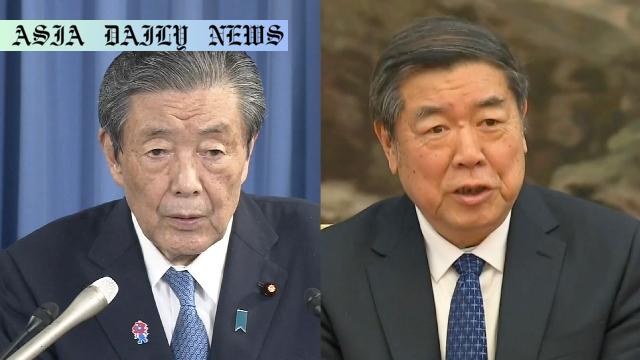Japan-China trade: Discussions revolved around seafood and beef import resumptions, panda loans, and strengthened partnerships.
- China has partially resumed imports of Japanese seafood after a two-year suspension.
- Discussions included reviving Japanese beef imports halted since 2001.
- Talks about the potential loan of giant pandas between the two nations signaled improved relations.

Promising Steps in Japan-China Trade Relations
The recent meeting between Japan’s Liberal Democratic Party (LDP) Secretary-General Moriyama Hiroshi and Chinese Vice Premier He Lifeng highlighted positive strides in Japan-China trade ties. Held in Osaka, Western Japan, the discussions encompassed a range of critical topics, including the resumption of seafood imports, restrictions on beef imports, and collaborative efforts like the potential loaning of giant pandas. This meeting also marked China’s willingness to address concerns and strengthen diplomatic and economic ties with Japan, illustrating a positive outlook for bilateral cooperation.
Resumption of Japanese Seafood Exports
One of the significant outcomes from the dialogue was China’s decision to approve the re-registration of three Japanese seafood exporters’ facilities for trade. This development comes after China had imposed a block on imports two years ago following Japan’s release of treated and diluted water from the Fukushima Daiichi nuclear power plant. The approval signals cautious optimism from Beijing, as the Vice Premier emphasized China’s interest in importing high-quality Japanese seafood that adheres to China’s stringent standards. This move aligns with efforts to rebuild trade bridges and promote Japan’s quality exports in China’s vast market.
Progress in Resolving Beef Import Restrictions
Another vital concern raised during the meeting was the 22-year-long suspension of Japanese beef imports by China. The import ban, enforced since 2001 due to an outbreak of Bovine Spongiform Encephalopathy (BSE), has remained unresolved despite a bilateral agreement signed in 2019. Vice Premier He Lifeng’s remarks suggested that Chinese agencies are actively addressing the matter, potentially opening the door for beef trade. While timelines have not yet been announced, such actions underscore China’s increasing willingness to mend historical trade differences.
Symbolic Discussions: Giant Panda Loan Talks
Amidst the trade discussions, cultural diplomacy took center stage as well. Talks around loaning new giant pandas to Japan indicated an intention to foster goodwill between the two countries. The Vice Premier highlighted his hope for the swift commencement of working-level dialogue to finalize agreements on panda loans, aiming for an early conclusion. This gesture holds symbolic significance, as pandas have historically been a cultural linkage in China’s diplomatic strategies. Strengthening such symbolic ties could further bolster maturation in broader Japan-China relations.
A Step Towards Strengthened Relations
The meeting in Osaka reflects an underlying theme of progress and positive engagement between Japan and China, especially with recent geopolitical tensions in Asia. Both nations have expressed a willingness to rebuild trade channels and diplomatic relations, furthered by practical actions and open communication. While areas like seafood and beef imports signal economic cooperation, cultural exchanges through symbolic gestures such as panda loans highlight deeper social and cultural connections. Moving forward, maintaining transparency and vibrant communication channels will be pivotal in ensuring the longevity and growth of such evolving partnerships.



Commentary
The Evolving Dynamics of Japan-China Trade Relations
The recent discussions between Japan’s LDP and China’s Vice Premier He Lifeng mark a significant chapter in Japan-China relations. As two major economic powers, the collaboration holds immense potential for reshaping the trade and cultural dynamics of East Asia. The partial resumption of seafood imports presents a promising start towards rebuilding confidence in bilateral trade. For Japan, gaining access to China’s vast market is a critical step for its export sectors, while China benefits from high-quality Japanese products.
Addressing Lingering Issues in Trade
It is noteworthy that progress on long-standing issues, such as the suspension of Japanese beef imports, highlights both nations’ commitment to resolving historical challenges. The lingering ban since the early 2000s symbolized a stalemate in trade pathways, but the willingness to move forward sends a broader message of advancing cooperation. While concrete results may take time, such open dialogue is crucial for setting the foundation for future agreements and greater trust.
Symbolism and Soft Power in Diplomacy
Beyond trade, cultural discussions, such as the consideration of new panda loans to Japan, provide vital avenues for soft diplomacy. Pandas have long symbolized friendship in China’s diplomatic engagements and could herald warmer ties. These symbolic acts serve not only as political gestures but as shared goodwill extending towards the citizens of both nations. By intertwining cultural exchanges with trade discussions, both Japan and China show a promising pathway for holistic engagement across multiple domains.
The Road Ahead
As Japan and China navigate their relationship amidst global challenges and regional complexities, fostering mutual respect and collaboration remains key. The actions resulting from these discussions could serve as a template for broader Asia-Pacific cooperation, where economic interdependence is matched with cultural understanding. Only through open dialogue, transparency, and actionable steps can both nations capitalize on their shared history and economic aspirations for a harmonious future.